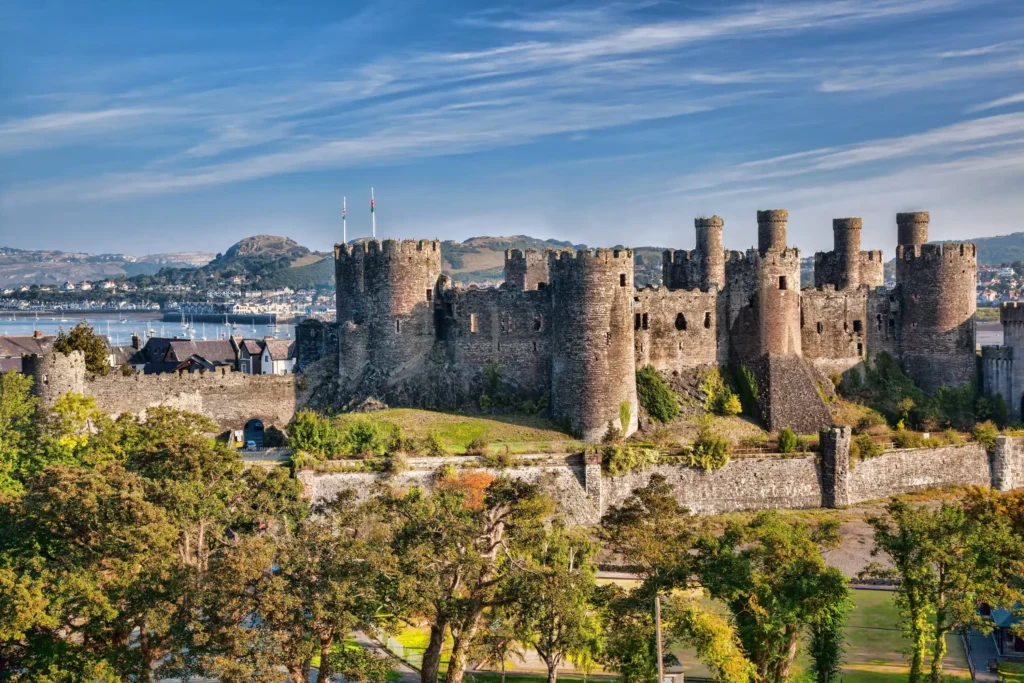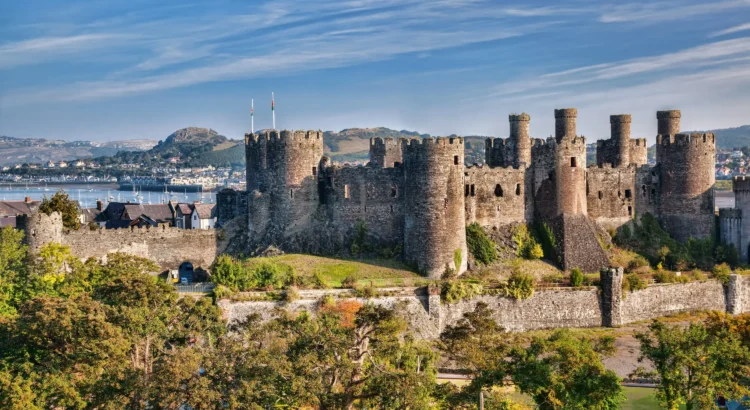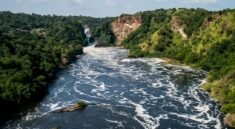
Nestled on the western edge of Great Britain, Wales is a land where myth and history intertwine beneath the shadows of crumbling castles and rolling green hills. With its ancient strongholds, dramatic coastlines, and deeply rooted Celtic culture, Wales offers a travel experience unlike any other. From exploring medieval fortresses to hiking along cliffside paths, and from listening to the lilting sound of Welsh spoken in mountain villages to joining traditional festivals filled with music and folklore, discovering Wales is like stepping into a living storybook—one filled with dragons, druids, and timeless beauty.
A Kingdom of Castles: Exploring Wales’ Fortified Past
Wales is often referred to as the “castle capital of the world”, and for good reason. This small country is home to more than 600 castles, each with its own tale of conquest, power, and intrigue. These stone relics are not just ruins of a bygone era; they are enduring symbols of Welsh identity and resilience.
Caernarfon Castle: The Crown Jewel
Standing proudly in North Wales, Caernarfon Castle is one of the most impressive medieval fortresses in Europe. Built by King Edward I in the late 13th century during his conquest of Wales, the castle was designed to intimidate and control. Its polygonal towers and massive stone walls are a marvel of military architecture, and it was here that Prince Charles was invested as Prince of Wales in 1969.
As you wander through its halls and battlements, it’s easy to imagine knights in armor patrolling the grounds, or kings plotting the fate of their kingdoms. Caernarfon is not just a relic—it’s a window into the turbulent medieval era that shaped modern Wales.
Conwy Castle: A Perfect Fortress
Nearby, Conwy Castle sits atop a rocky hill overlooking the Conwy Estuary. Another of Edward I’s “Iron Ring” of castles, Conwy is remarkably well-preserved, with eight massive towers, high curtain walls, and breathtaking views of the surrounding town and coastline. The adjacent town walls, still intact, form a protective embrace around one of the most charming medieval towns in Britain.
Carreg Cennen and Castell Coch
In the south, Carreg Cennen Castle offers a more romantic experience. Perched dramatically on a limestone cliff, its ruins evoke a sense of mystery and isolation. Explore the cave beneath the castle or take in panoramic views of the Brecon Beacons—this is one of Wales’ hidden gems.
Also in the south, Castell Coch, or the “Red Castle,” is a 19th-century fairytale fortress designed in Victorian Gothic style. Though not ancient, its whimsical turrets and richly decorated interiors evoke the magic of Arthurian legends.
The Wild Welsh Coast: Rugged, Untamed, and Sublime
While the castles tell stories of power and conflict, the coastline of Wales speaks of nature’s raw beauty and timeless serenity. Stretching over 1,400 kilometers, the Welsh coast offers towering cliffs, sweeping beaches, picturesque harbors, and abundant wildlife.
Pembrokeshire Coast National Park
In the southwest, Pembrokeshire Coast National Park is Britain’s only coastal national park, and it’s a paradise for hikers, kayakers, and wildlife watchers. The Pembrokeshire Coast Path, a 300-kilometer trail, offers ever-changing vistas of sea-sculpted cliffs, secret coves, and ancient promontory forts.
Towns like St Davids—Britain’s smallest city—are steeped in religious history and offer beautiful cathedrals, art galleries, and cozy cafés. Nearby Whitesands Bay is perfect for surfing or just relaxing on golden sands while puffins nest in the offshore islands.
Llyn Peninsula and Snowdonia’s Shores
The Llyn Peninsula, jutting into the Irish Sea, is a designated Area of Outstanding Natural Beauty. It’s a haven for wildlife and a heartland of the Welsh language. Small fishing villages like Aberdaron and Nefyn offer peaceful escapes and cultural authenticity.
To the north, Snowdonia National Park not only boasts Wales’ highest peak, Yr Wyddfa (Mount Snowdon), but also rugged coastal stretches like Harlech Beach, where medieval Harlech Castle rises above rolling dunes.
Gower Peninsula
Closer to the south lies the Gower Peninsula, the first place in the UK designated as an Area of Outstanding Natural Beauty. From the limestone cliffs of Rhossili Bay, often voted one of the best beaches in the world, to the surfing hotspot of Langland Bay, Gower is a microcosm of Welsh coastal charm.
Celtic Traditions: A Culture Rooted in Legend and Language
Wales is one of the oldest countries in Europe in terms of continuous cultural identity. The Celtic traditions of Wales are preserved not only in its art and music but most importantly in its language, mythology, and festivals.
The Welsh Language (Cymraeg)
Spoken by nearly a third of the population, Welsh is one of the oldest living languages in Europe. It’s seen a dramatic revival in recent decades, supported by education, media, and national pride. Hearing Welsh spoken in shops, pubs, and classrooms gives a sense of connection to ancient roots and enduring community spirit.
Even place names tell stories: from Llanfairpwllgwyngyllgogerychwyrndrobwllllantysiliogogogoch—one of the longest place names in the world—to evocative names like Betws-y-Coed and Llandudno, every syllable carries history.
Music and Storytelling
Music is central to Welsh culture, often referred to as the “Land of Song.” Traditional male voice choirs and folk music continue to thrive, while modern artists blend tradition with innovation.
The ancient tradition of the bard, or poet-musician, lives on in events like the Eisteddfod, a national festival of music, poetry, and performance. Rooted in medieval times, the Eisteddfod celebrates artistic expression and cultural heritage, drawing thousands each year.
Myth and Legend
Wales is rich in mythology, particularly the Mabinogion, a collection of medieval tales filled with warriors, druids, magical creatures, and tragic romances. Figures like Merlin, King Arthur, and Rhiannon are woven into the landscape and folklore of Wales, giving places like Beddgelert and Dinas Emrys an aura of enchantment.
Even natural landmarks have their legends. The Brecon Beacons are said to hide sleeping dragons, while lakes like Llyn y Fan Fach are linked to fairy maidens and enchanted healers.
Small Towns With Big Hearts
While Wales’ natural and historical wonders are spectacular, its towns and villages are where visitors truly feel the warmth of Welsh hospitality.
Tenby
A picture-perfect seaside town with pastel-colored houses, Tenby offers sandy beaches, cobbled streets, and a relaxed atmosphere. Its medieval walls and harbor tell of its strategic past, while its boutiques and cafés reflect its artistic spirit.
Llangollen
Nestled in the Dee Valley, Llangollen is known for its International Musical Eisteddfod, horse-drawn canal rides, and historic abbey ruins. It’s also a gateway to the Pontcysyllte Aqueduct, a UNESCO World Heritage Site.
Betws-y-Coed and Hay-on-Wye
Betws-y-Coed is a haven for hikers and nature lovers, with easy access to waterfalls, forests, and mountain trails. Meanwhile, Hay-on-Wye, on the border with England, is famous for its literary culture and annual Hay Festival, which attracts writers and readers from around the world.
Sustainability, Nature, and Adventure
Wales is also at the forefront of eco-tourism and sustainable travel. National parks like Snowdonia, Brecon Beacons, and Pembrokeshire promote conservation, clean energy, and responsible hiking.
For adventure seekers, Wales offers ziplining over quarries, coasteering along jagged shores, mountain biking in forested trails, and dark sky reserves for stargazing.
Wildlife lovers will find an abundance of seabirds, seals, otters, and even dolphins off Cardigan Bay. And for those seeking mindfulness, the quiet valleys and ancient woodlands provide perfect places for yoga retreats, forest bathing, or simply slowing down.
Final Thoughts
Wales may be small in size, but its heart beats with centuries of history, folklore, and cultural pride. Its castles whisper tales of kings and conquests, its rugged shores inspire awe and adventure, and its Celtic traditions invite travelers to connect deeply with the past and the land.
To discover Wales is to awaken your sense of wonder. Whether you find yourself walking the battlements of Caernarfon, hiking coastal cliffs in Pembrokeshire, or sipping tea in a cozy village where the language of the Celts still thrives, Wales leaves you with something lasting—an experience of a land as old as myth, yet as vibrant as the people who call it home.



